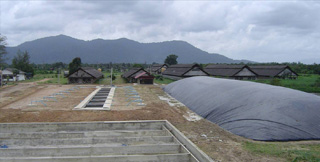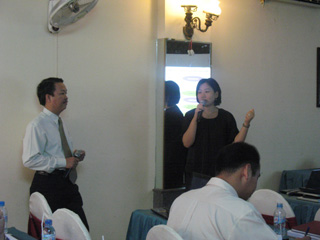HTML clipboard
The clean development mechanism:
still strange a concept.
According to ACG Co., Ltd., peasant’s utilization of waste used
as gas and power energy,…have been long applied in developed countries
worldwide. Breeders in these countries are making a lot of profits from trading
emission credits. In Asian region, except China, India, our neighbors such as
Thailand and Malaysia,…, being the exclusive Vietnam-based representative who is
able to trade emission credits throughout the world, ACG is proceeding with the
investigation on this potential market and combines with C.P Company to work on
CDM projects in animal breeding farms. Thanks to it, emission reduction credits
can be traded and listed on the emission trading.
 |
|
|
Applying Biogas method in the treatment of animal breeding waste
|
|
But what is CDM? CDM is the abbreviation of Clean Development
Mechanism coming into existence in Kyoto Protocol since Dec. 1997 and applied
since 16 Feb.,2005 with many regulations on the portion of emission reduction in
developed countries and forms of punishment reserved for those failing to comply
with it. The protocol forces member countries to reduce greenhouse gas emission
to 5.2% compared to the emission rate in 1990 (the period 2008 – 2012) at any
price. This carries a really heavy responsibility for industrialized countries
since the investment in gas emission in these countries is substantial. It also
causes many effects on their productivity of key industries.
Aiming to help these countries to gain their objectives, Kyoto
Protocol establishes 3 “flexible mechanisms”: “Gas Emission Trade” (selling and
buying emission credits among developed countries), “Implementation” (selling
and buying emission credits through projects of emission reduction established
in developed countries), and “Clean Development Mechanism”. CDM is the sole
mechanism raising issues concerning developing countries. This mechanism allows
developing countries to release one of their responsibilities through those
projects reducing gas emission in developing countries. The main objective of
CDM is to make the growth of developing countries more sustainable, and to
facilitate the achievement of their targets in emission reduction through the
projects developed in these countries.
As any CDM project comes into operation, its product will be CERs
and the profits will be achieved through CER tradings. Due to the participation
of Russia, CERs have been marketed and become a kind of goods. At present,
European Union and some developed countries are buying these emission credits.
The content of greenhouse gas that has been absorbed from each CDM project will
be measured by the internationally-approved methods and shown in the measurement
unit called CERs – “Certified Emission Reductions” (1CER = 1 ton of CO2). Based
on the information from ACG Company, every CER is pricing USD 8-10.
CDM: mutual interest!
C.P Company initiates the combination between them and ACG
Company in order to apply the clean development mechanism for animal breeding
farms and maintains social objectives in reducing environmental pollution, which
is gaining much consent from farm householders. Mr. Kieu Minh Luc: Assistant to
Deputy General Director of C.P Animal Husbandry Co., Ltd., who is in charge of
animal breed genetics said, “C.P Co. sees the feasibility in trading breeder’s
emission credits, so we actively cooperates with ACG to study the implementation
of this project to bring about profits for animal breeders. This also
contributes to sustaining environment and social security in Vietnam”.
 |
|
|
Asian Carbon Company presents the ability in implementing the
establishment of clean development mechanism for animal breeding
farms |
|
In Vietnam, there are currently many farm owners applying Biogas
method to treat waste to generate gas, warming and power energy,… They are,
however, just small scales. Therefore, this project will benefit all when it
comes into effect. As regards our environment, it will help to reduce a
substantial amount of substances harmful to the atmosphere, and minimize
stinking smell influencing over the neighboring areas. As regards our economy,
animal breeders can save a large amount of expense and concurrently gain profits
from the trading of emission reduction credits. As regards our nation, this
project will make a contribution in Vietnam’s common attempt in executing all
terms and conditions mentioned in the protocol.
As estimated, one farm with a scale of 10.000 pigs will reduce
60.000 tons of CO2 per annum, if their waste treatment applies the clean
development mechanism. Additionally, the technological transfer from modern
countries is also a considerable interest which enables local peasants to
improve their outdated method with low efficiency. We can realize the
significance of such a project in both humane and economic face. However, to
list emission credits on the tradings, we have to generate many processes under
strict supervision from environmental international organizations and experts.
Ms. So Yong Jang, representative of ACG Company told that, after study, if this
project is truly feasible, the company will seek the supports in capital,
advance technology, human resource to help animal breeding farms to invest in
waste treatment, to implement the project in Vietnam and trade emission
reduction credits throughout the world. After the workshop, the company will
send one datasheet to each farm, including the survey questionnaire about the
feasibility of this project in the upcoming time.
Reported
by Nguyen Thuong, Translated by T&V